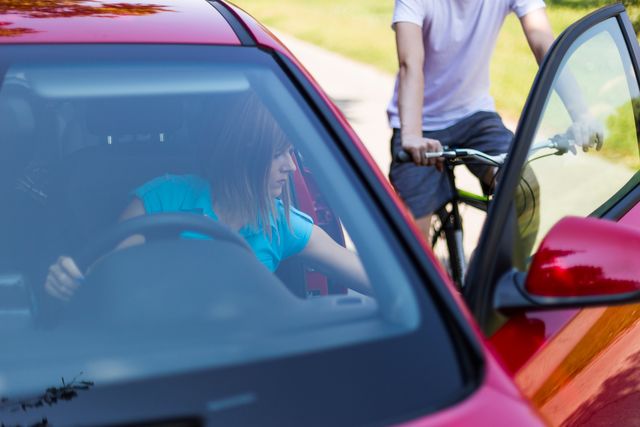Common Causes of Bicycle Accidents in Pennsylvania
In Pennsylvania, bicycling accidents can arise from a variety of factors, each posing significant risks to cyclists. If you have been injured by one of these common causes of bicycle accidents, an experienced bicycle accident attorney at PhillyLaw will offer a free consultation for your bicycle accident case to determine your options to seek compensation for your injuries.
Common causes of bicycle accidents include:

Distracted Driving
One of the most prevalent causes of bicycle accidents is distracted driving, where car drivers fail to notice cyclists on the road, leading to dangerous bicycle crashes.
Poor Road Conditions
Additionally, poor road conditions, including potholes, uneven pavements, and debris, contribute to accidents by impeding safe cycling.
Dooring
Cycling near parked cars also presents the risk of “dooring,” where car doors are abruptly opened in a cyclist’s path.
Intersection Accidents
Intersections are notorious hotspots for bike accidents due to the complex dynamics of vehicle and bicycle traffic merging or crossing paths.
Insufficient Cycling Infrastructure
Insufficient cycling infrastructure, such as a lack of dedicated bike lanes, exacerbates the situation by forcing cyclists to share narrow roads with faster and larger vehicles.
Impaired Driving
Impaired driving is another significant cause of bike accidents. When drivers are under the influence of alcohol, drugs, or even prescription medications, their judgment, reaction times, and overall ability to drive safely are severely compromised. This increases the risk of collisions with bike riders, who are more vulnerable and less visible on the road.
Excessive Speed
Excessive speed significantly contributes to the severity and frequency of bike accidents. When drivers exceed the speed limit or drive too fast for conditions, their ability to react to cyclists on the road is drastically reduced.
Reckless Driving
Reckless driving is a perilous behavior that dramatically increases the likelihood of bicycle collisions. This includes aggressive maneuvers such as tailgating, unsafe lane changes, and disregarding stop signs or red lights, all of which can endanger cyclists. Cyclists, with their smaller profile and slower speeds, are often overlooked by reckless drivers, making them especially vulnerable to sudden, unpredictable movements of motor vehicles and oncoming traffic. The consequences of such actions can be dire, leading to serious injuries or even fatalities among the bicycling community.
Understanding these common causes of bicycle accidents can help cyclists avoid collisions in the future.
Why Bike Accidents Occur
Bike accidents primarily occur due to a mix of environmental conditions, human error, and infrastructural inadequacies.
Visibility
At the core of many accidents is the visibility issue; cyclists are smaller, less protected, and often less visible than motor vehicles, leading to oversight by drivers, especially in low-light conditions.
Human Error
Human error also plays a significant role, with both cyclists and drivers potentially failing to adhere to road rules or pay adequate attention to their surroundings.
Environmental Factors
Environmental factors, such as poor weather, also contribute by reducing visibility and road traction. Collectively, these factors create a challenging environment for cycling safety.
What to Do When Bicycle Accidents Happen
When involved in a bicycle accident, it’s crucial to take certain steps to ensure your safety and protect your legal rights.
- Immediately after the bike accident, assess yourself for injuries and seek medical attention if needed; some injuries might not be immediately apparent.
- If possible, move to a safe location to avoid further danger.
- It’s important to call the police to the scene so that an official report can be filed; this report can be critical if you need to make a claim.
- Exchange information with the other party involved, including names, contact details, and insurance information, but avoid discussing fault at the scene.
- Document the accident by taking photos of your bicycle, the vehicle, any visible injuries, and the surrounding area.
- Look for witnesses who saw what happened and obtain their contact information.
- After these immediate steps, consider consulting with a legal professional specializing in bicycle accidents to discuss your options regarding claims for damages or injuries. Documenting and reporting the incident comprehensively can provide significant support in navigating the aftermath of an accident.
How to Prevent a Bicycle Accident
Taking safety precautions to prevent a bicycle accident requires a combination of vigilance, adherence to traffic laws, and proper maintenance of cycling equipment. Firstly, wearing appropriate safety gear, especially a properly fitted helmet, significantly reduces the risk of serious injury. Bicycle riders should also ensure that their bicycles are in good working order, with particular attention to brakes, tires, and lights. Visibility to motorists is crucial, so wearing bright or reflective clothing and using lights and reflectors when cycling in low-light conditions are recommended strategies.
Following the rules of the road is paramount; this includes using a designated bike lane or bike path when available, signaling turns, and obeying traffic signs and signals. Cyclists should be particularly cautious at intersections and when riding near parked cars to avoid “dooring” incidents. Additionally, improving one’s cycling skills through formal training can enhance maneuverability and road awareness, further mitigating accident risks.
Common Bicycle Injuries
Bicycle accidents can result in a wide range of bicycle injuries, from minor scrapes and bruises to more severe injuries. One of the most common injuries cyclists face is road rash, a skin abrasion caused by sliding across the pavement, which can range from superficial to deep wounds requiring medical attention. Head injuries, including concussions and traumatic brain injuries, are also prevalent among cyclists, especially those not wearing a helmet at the time of the accident. Fractures and broken bones are frequent, with the wrists, arms, and clavicle being particularly vulnerable during falls. Soft tissue injuries, such as sprains and strains, often occur in the legs, back, and neck as a result of the force exerted during a crash. In more severe cases, cyclists can experience internal injuries or spinal cord injuries, leading to long-term or permanent disability. Ensuring proper safety measures and wearing protective gear are crucial steps in mitigating the risk and severity of these injuries.
Fatal Accidents
Despite precautions, fatal bike accidents still occur, highlighting the need for heightened safety measures and infrastructure improvements. When a cyclist is involved in a severe collision with a motor vehicle, the lack of protective barriers compared to those in cars puts cyclists at a significantly higher risk of fatal injuries. Head trauma is a leading cause of death among cyclists, which emphasizes the critical importance of helmet use. However, even with protective gear, the force exerted by a collision with a vehicle can lead to fatal outcomes. High-speed roads, intersections with poor visibility, and areas lacking dedicated bike lanes are particularly notorious for such tragic incidents. These accidents not only bring irreversible loss to families and communities but also raise urgent questions about road-sharing practices and the need for comprehensive traffic safety reforms to protect vulnerable road users.
Insurance Coverage for Bicycle Accidents
Insurance plays a crucial role in providing financial protection following a bicycle accident. Cyclists need to understand the types of insurance that can cover bike accidents and how to claim the necessary compensation for damages and injuries. Generally, most bike accidents are covered under the following types of insurance:
- Auto Insurance: Surprisingly to some, auto insurance policies can often provide coverage for bicyclists involved in collisions with motor vehicles. This is particularly true if the cyclist is not at fault and the motorist’s insurance includes liability coverage. Cyclists should also check their own auto insurance company for uninsured/underinsured motorist coverage, which can offer protection if the driver at fault lacks sufficient insurance.
- Homeowners or Renters Insurance: These policies often cover personal property damage, including damage to bicycles, whether the incident occurs at home or elsewhere. Some policies may also provide liability coverage if the cyclist is responsible for an accident that causes injury or property damage to others.
- Specialized Bicycle Insurance: For avid cyclists or those who own high-value bicycles, specialized bicycle insurance policies can offer comprehensive coverage, including theft, damage, and liability. These policies are tailored specifically to the needs of cyclists and can provide greater protection than standard homeowners or renters insurance policies.
When filing a claim, it’s crucial to report the accident to your insurance provider as soon as possible, providing all necessary documentation, including police reports, medical records, repair bills, and any evidence of the accident scene. Understanding your policy’s coverage, limitations, and the claim process is essential in ensuring that you are adequately compensated for losses and injuries sustained in a bicycle accident.
PhillyLaw Will Help Injured Bicyclists Seek Compensation for Their Injuries
Choosing PhillyLaw as your representation for bike accident cases in Pennsylvania means entrusting your case to experienced bike accident lawyers. Our legal team possesses a deep understanding of both the pleasures and hazards of cycling, coupled with comprehensive knowledge of state and local traffic laws that apply to motor vehicle accidents. This unique blend of insight and expertise empowers us to advocate effectively for the rights of cyclists. Whether navigating the complexities of insurance claims or pursuing litigation against at-fault vehicle drivers, our lawyers are equipped to handle every aspect of your case with the utmost care and professionalism. At PhillyLaw, we are committed to helping our clients achieve the best possible outcomes, ensuring that you receive the compensation and justice you deserve. Contact us today for a free consultation.


